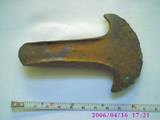To the south of Primrose Hill, by the Roman road below Coverdale farm, an Iron Age/ Romano-British settlement site has been recently discovered. A number of enclosures and hut circles have been identified and recorded. The site stands on a line between the tumulus summit of Weets Hill to the south and the hill fort summit of Ingleborough to the north.
COVERDALE ENCLOSURES/SETTLEMENT SD 849468 (SMR: PRN 1918)
A grassed hollow-way leads into the settlement and a small stream bisects the site. Circular, rectangular and linear features can be easily discerned and a number of large stones protrude the turf surface of these features. The stream rises as a spring on the southern edge of the site and can be clearly seen to have been once enclosed by regular stonework to form a well. On yesterday's visit to the site we found a number of shards of fine-grained Roman pottery and a fragment of black burnished ware of Roman origin in the earth by the side of the spring. A small amount of slag from iron smelting was also found near the spring. The waters from the spring that pass through the settlement cross the Roman road (between the Roman cavalry forts of Ribchester and Elslack) at a point where the road makes a slight turn before climbing the rise to Brogden Hall. Here spanning the road just above the stream is to be found a large rectangular slab of worked stone some 8ft. in length, 2ft. in width and 18inch in depth. The stone has a chamfer on one edge of its length, and at one end of the face of the stone are two Lewis holes close together set at slight angles. The cobbled surface of the Roman road is clearly visible at this point and the aggar of the road is clearly defined for some great distance on either side of the ‘crossing’. As to the purpose and the positioning of the stone, plus the location of a ‘settlement’ with possible sacred spring at this point one can only surmise and further investigation is needed.










